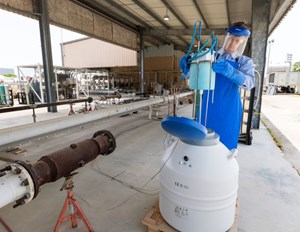News
SwRI evaluates effects of H2 and natural gas blends on storage tanks
Southwest Research Institute (SwRI) is taking on the challenges of a H2-powered future. In collaboration with NYSEARCH, a nonprofit research and development organization for the gas industry serving utility members across North America, SwRI is investigating how blending H2 into liquid natural gas (LNG) could affect the integrity of the LNG storage tanks.
Natural gas is widely used to power appliances and heat homes. By blending H2 into these existing natural gas streams, utilities can reduce the carbon footprint of energy delivery while leveraging current natural gas infrastructure. In the next decade, some gas companies are planning to use H2-natural gas blends to curb carbon emissions.
LNG peak shaving facilities help stabilize energy supply and pricing during periods of high demand. In these systems, natural gas is liquified and stored in massive cryogenic tanks during times of low usage, typically in summer, and regasified during winter months when demand surges. The potential introduction of H2 into these systems raises important safety questions.
“A new challenge for blending H2 into natural gas distribution lines concerns energy storage mechanisms,” said Angel Wileman, who leads SwRI’s Thermofluids Section. “During the summer months, the demand for natural gas decreases, so it is liquefied and stored in large tanks until the winter. We are investigating what happens to these tanks when H2-natural gas blends undergo the liquefaction process, which transforms gas into its liquid phase, and are stored for months.”
SwRI is addressing a major concern that the temperature of the liquid natural gas, when mixed with H2, may dip below the storage tank’s temperature rating, affecting its safety and pressure integrity. SwRI is conducting experiments to determine if these tanks can endure lower temperatures, a process called thermal physical property testing.
“First, we’re going to measure the temperature of the liquefied natural gas as H2 is introduced into it through a bubbling mechanism, to simulate the H2 being introduced to the large storage tanks,” said SwRI’s Jessica Brysch, the project manager. “This experiment will allow us to study how H2 blends affect the cryogenic temperature of the LNG and the integrity of the steel tank materials.”
To simulate H2 bubbling into liquid natural gas inside the tanks, SwRI is building a custom test rig that introduces H2 into an LNG-filled tank via a porous stone known as a sparger. The rig will also monitor temperatures inside the tank for the thermal physical property testing.


